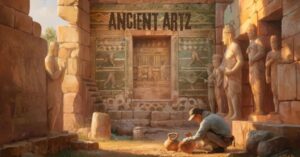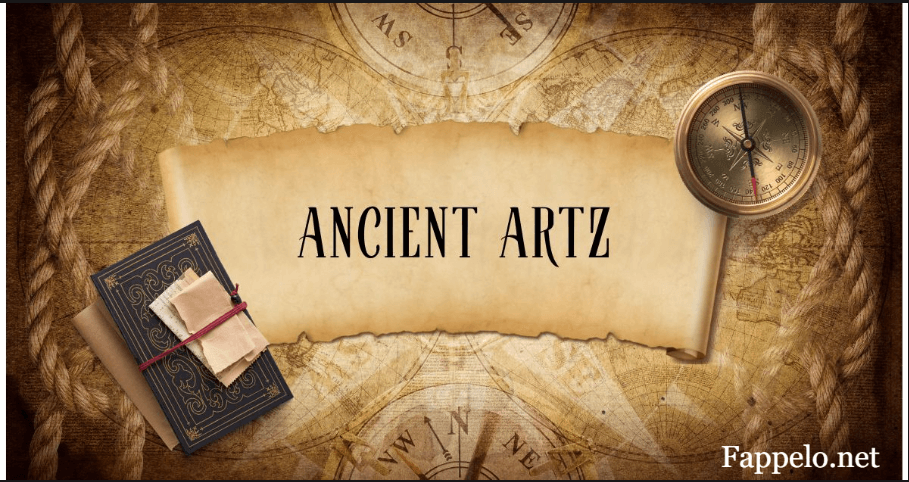Introduction
From the moment humans began drawing on cave walls, art has been a mirror of life, beliefs, and imagination. Ancient artz hold a powerful place in history.
These creative works are more than just old artifacts; they are voices from the past. They speak to us through color, form, and symbol. Their beauty and meaning continue to spark ideas and emotions in people today.
In this article, we will look at how ancient artz have influenced the modern world. We will explore different forms of these timeless works, how they connect us to history, and why they still matter now.
What Are Ancient Artz?

Ancient artz include any artistic work created by early human civilizations. These may be cave paintings, sculptures, carvings, pottery, jewelry, or building decorations. Each of these reflects the life, thoughts, and skills of the people who made them.
From the Egyptian pyramids to the statues of Ancient Greece, ancient artz give us a glimpse into how people lived, worshipped, and saw the world. Even though these works are thousands of years old, many still feel fresh and powerful today.
The Beauty of Simplicity in Ancient Artz
One of the most amazing things about ancient artz is their simple, clear expression. There were no machines, digital tools, or fancy materials. Artists used natural items like stone, clay, and minerals.
For example, the cave paintings in Lascaux, France, show animals drawn with earth pigments. These paintings are over 17,000 years old, but they still impress viewers with their motion and detail. This shows that great art doesn’t need complex tools—just creativity and skill.
Ancient Artz in Different Cultures
Each culture had its own style of ancient artz. Let’s take a quick look at a few:
Egyptian Art
Egyptian ancient artz focused on gods, pharaohs, and the afterlife. Wall paintings and carvings in tombs tell stories and honor the dead. The use of size in their art—making pharaohs larger than others—showed status and importance.
Greek and Roman Art
Greek and Roman ancient artz aimed for realism and beauty. Their statues, mosaics, and architecture show a deep interest in the human body and nature. Many of their styles still inspire buildings and sculptures today.
Chinese and Indian Art
In Asia, ancient artz were full of spiritual meaning. Chinese ink paintings and Indian temple carvings focused on harmony, gods, and daily life. These traditions are still alive in modern Asian art.
How Ancient Artz Influence Modern Art
Today, many artists look back to ancient artz for ideas. From shapes and colors to stories and techniques, these early works still shape new creations.
For example, Pablo Picasso was inspired by African tribal masks and cave paintings. Many modern artists use old symbols or styles in their work to show respect for the past or to create new meaning.
Even graphic designers and architects study ancient artz to learn balance, form, and simplicity. This shows how lasting and useful these early works are.
Lessons from Ancient Artz
Ancient artz teach us many things. Here are some key lessons:
1. Art Is for Everyone
People in all early societies made art. It was not just for the rich or powerful. This shows that creativity is a human need.
2. Art Can Last
Many ancient pieces have survived thousands of years. They remind us that creative work can stand the test of time.
3. Art Tells Stories
Ancient pieces often tell stories—of gods, battles, love, or daily life. These help us learn about people who lived long ago.
Ancient Artz in Daily Life
You might not notice it, but ancient artz are all around us. Many of the things we use today have roots in early design. Pottery, tools, clothes, and even furniture shapes often borrow from old styles.
In fashion, tribal patterns or gold jewelry styles reflect designs from ancient artz. In home décor, stone carvings or classical statues add a timeless touch. Even tattoo artists study ancient symbols to use in modern body art.
Museums and Ancient Artz
Museums around the world hold large collections of ancient artz. Visiting them is like traveling back in time. You can see items that were touched, used, and loved by people thousands of years ago.
Some top places to view ancient art include:
- The Louvre in Paris (home of Egyptian and Greek works)
- The British Museum in London
- The National Museum in New Delhi
- The Met in New York
These museums help keep ancient artz safe and share their value with new generations.
Technology and Ancient Artz
Modern technology helps us study ancient artz in new ways. Scientists use 3D scans and digital tools to restore broken items or see hidden layers in paintings.
Online galleries now let people around the world see ancient works without traveling. This means more people can learn about and enjoy these treasures.
Technology also helps artists bring ancient artz into new media like virtual art, video games, and films. This shows how old art can live in modern times.
Protecting Ancient Artz
Many ancient artz are fragile. Time, weather, and even war can damage them. That’s why many groups work to protect these treasures.
Simple things like not touching art in museums or supporting local heritage efforts can help. We all play a part in saving these important pieces of human history.
Why Ancient Artz Still Inspire Us
Even with all the changes in our world, ancient artz still speak to us. Why? Because they come from real people with real hopes, fears, and dreams. Their messages are human and timeless.
Whether it’s a handprint on a cave wall or a golden statue of a god, each piece reminds us of where we come from. They show that creativity is part of being human.
Conclusion
Ancient artz are more than just things from the past. They are alive in our minds, homes, and culture. They teach us, touch us, and inspire us.
By looking at ancient artz, we connect with our roots. We learn that even thousands of years ago, people used art to show love, fear, joy, and wonder—just like we do now.
So next time you see an old sculpture or a simple cave drawing, remember: it’s not just history. It’s human spirit, made visible. And it still has something to say.



